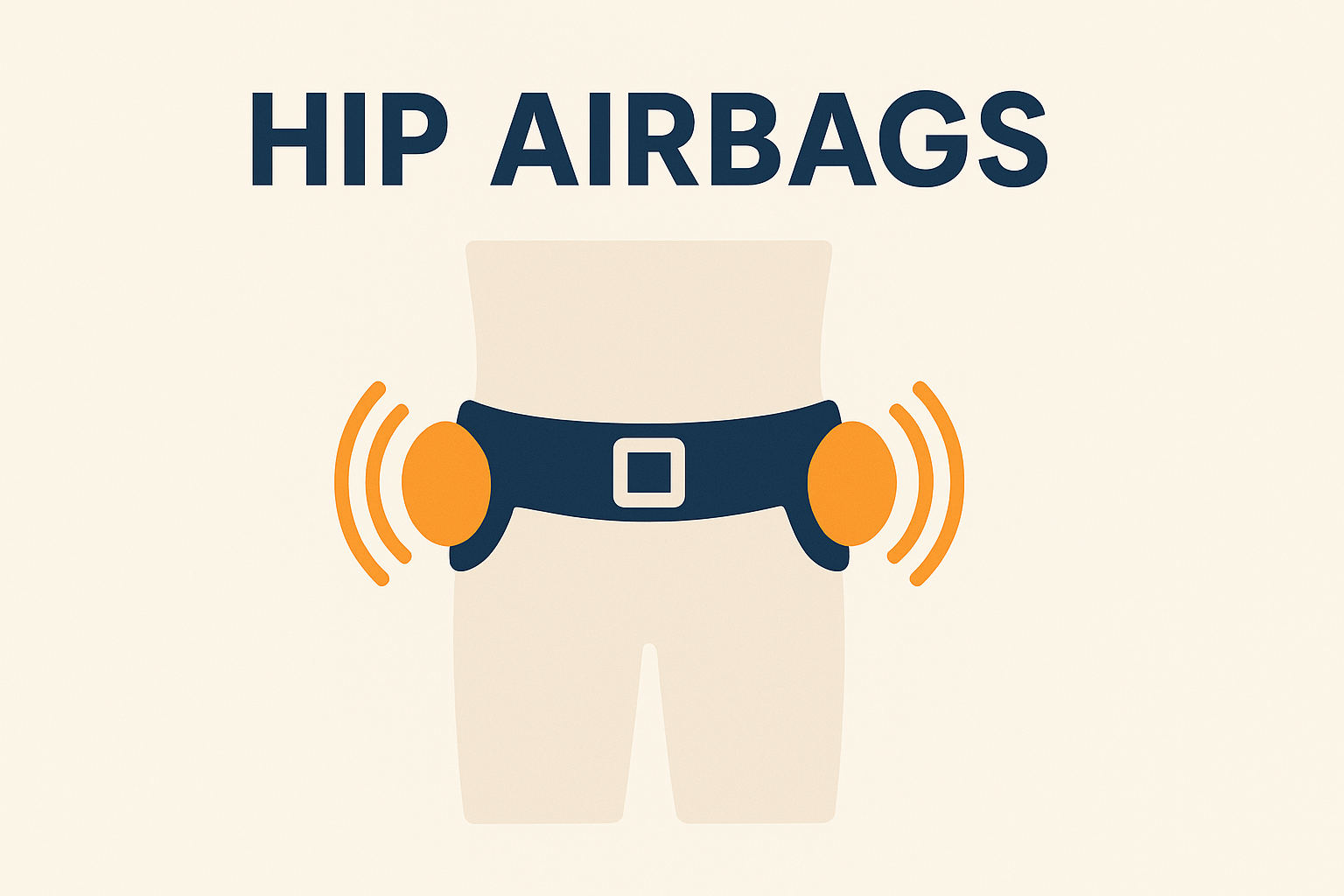
Newsletter Subscribe
Enter your email address below and subscribe to our newsletter

Enter your email address below and subscribe to our newsletter


This is part of our “Tools You Don’t Know That Could One Day Save Your Life” series.
Disclaimer: This article provides general information and should not replace professional medical advice. Always consult with healthcare providers about individual safety planning and fall prevention strategies.
When an 82-year-old grandmother falls in her kitchen while making breakfast, families face a devastating reality. Hip fractures often lead to loss of independence for older adults, and recent systematic reviews indicate that one-year mortality rates following hip fractures have improved significantly from historical figures, with current rates around 21% in the United States when fractures receive optimal treatment. Traditional fall prevention advice—”be more careful,” “remove trip hazards,” “use a walker”—assumes you can prevent falls entirely. But what happens when the very conditions that put someone at risk also make falls more likely to happen?
In recent years, a breakthrough approach has emerged: wearable airbag technology that deploys in milliseconds to protect hips during serious falls.
The Reality: Hip fractures represent a major cause of hospitalization for older adults; traditional prevention assumes you can avoid all falls
The Innovation: Wearable airbag devices detect serious hip-impact falls and deploy protection rapidly
The Breakthrough Factor: Works when falls happen, not requiring you to prevent them entirely
The Bottom Line: Personal airbag technology that functions even when balance, medication, or medical conditions make falls more likely
Standard fall prevention advice assumes capabilities that certain conditions systematically remove. “Remove trip hazards” requires recognizing dangers consistently. “Move slowly and carefully” assumes medication side effects don’t cause dizziness or confusion. “Use assistive devices properly” depends on remembering to use them and understanding their limitations.
This creates a fundamental challenge: the very conditions that increase fall risk also make traditional prevention advice harder to follow consistently.
Hip fractures represent a serious health challenge for older adults. According to the Centers for Disease Control and Prevention, approximately 300,000 older adults are hospitalized for hip fractures annually in the United States, with falls causing 83% of hip fracture deaths.
Recent systematic reviews indicate that one-year mortality rates following hip fractures have improved significantly from historical figures, with current rates around 21% in the United States when fractures receive optimal treatment. However, this still represents a substantial increase in mortality risk compared to older adults without hip fractures.
The economic impact is equally significant, with fall-related injuries among older adults costing approximately $50 billion annually, with Medicare covering about $29 billion of these costs. Beyond the immediate medical costs, hip fractures often result in loss of independence, with research indicating that many older adults experience significant functional decline following hip fractures, with a substantial percentage unable to regain their previous level of independence.
Traditional fall prevention focuses on eliminating risks before they cause falls. But hip airbag technology works differently—it protects you when falls actually happen.
The numbers behind the challenge
Wearable hip protection combines motion sensors with rapid airbag deployment to cushion impact before bone-breaking forces occur. Unlike smartphone fall detection or medical alert devices, these tools deploy physical protection during the fall itself.
Motion Detection: Sensors continuously monitor movement patterns to distinguish normal activity from serious falls
Fall Recognition: Algorithms analyze motion to detect patterns that lead to hip-impact falls
Rapid Deployment: Rapid inflators deploy protective cushioning around the hip area
Impact Protection: Airbags inflate to reduce the force of impact on hip bones
On April 15, 2025, the FDA granted marketing authorization to ActiveProtective’s Tango Belt (DEN240021)—the first wearable airbag device approved for preventing hip fractures in the United States. The device received Breakthrough Device Designation, reflecting its potential to significantly improve care for older adults at risk of major fall injuries.
Clinical Trial Results: In a multicenter premarket clinical study, the Tango Belt demonstrated a 91% reduction in fall-induced hip fractures when used alongside standard care compared to standard care alone. Clinical trials also demonstrated significant reductions in fall-related injuries and healthcare utilization.
Note: Clinical trial results may not reflect real-world outcomes for all users.
Automatic Operation: The device works without requiring any action from the wearer—important for people with cognitive changes or conditions that affect awareness
Extended Wear: Designed for day and night use, including during sleep
Connectivity: Available connectivity features can send alerts to family and caregivers when falls occur
Activity Monitoring: Optional features may track activity without restricting movement
Prescription Status: As an FDA-approved medical device, insurance coverage may be possible
From fall detection to injury prevention in milliseconds
Motion sensors monitor for serious hip-impact falls
Algorithms distinguish normal movement from dangerous falls
Airbags inflate around hips in milliseconds
Impact forces reduced before bone-breaking contact
Wearable hip airbags address fundamental barriers that make traditional fall prevention challenging for many people:
The device protects during falls regardless of whether someone followed prevention advice perfectly or forgot to use assistive devices.
Functions even when medication side effects, movement disorders, cognitive changes, or other conditions increase fall risk.
Allows people to maintain activities and routines while providing a safety net, rather than restricting movement.
Provides peace of mind for family members while allowing their loved ones to maintain dignity and autonomy.
However, important barriers remain:
While anyone concerned about fall risk can potentially benefit from wearable protection, these devices particularly serve people whose circumstances make traditional prevention challenging:
Conditions that affect balance, coordination, or movement control can cause falls despite careful prevention efforts. Airbag technology provides protection during unpredictable episodes.
Memory or awareness changes may affect ability to remember or follow fall prevention strategies consistently. Automatic protection removes the cognitive burden while preserving mobility.
Multiple medications can cause side effects like dizziness, confusion, or changes in blood pressure that may lead to falls. Wearable protection works regardless of medication effects.
After surgery, illness, or injury, balance and strength may be temporarily compromised. Airbag protection can support confidence during recovery periods.
People who want to maintain exercise, hobbies, and social activities can do so with additional protection rather than activity restriction.
The wearable airbag market includes several options with different features and availability:
ActiveProtective Tango Belt
Alternative devices are available internationally with different regulatory approvals outside the US. Import considerations and regulatory differences should be evaluated for US use.
Understanding what wearable airbags don’t do is equally important:
If you’re considering wearable airbag protection, here are steps to begin:
Respect Individual Choice: When possible, involve the person in decisions about using protective technology, respecting their preferences and autonomy.
Plan for Adjustment: Allow time for getting used to new technology and incorporating it into daily life.
Maintain Perspective: Understand that technology provides additional protection but doesn’t eliminate all risks or replace other safety measures.
Emergency Preparedness: Know how to respond when alerted to a fall, including when emergency services may be needed.
FDA-approved devices like the Tango Belt may be eligible for insurance coverage:
Insurance coverage typically involves:
Research and development continue on:
Wearable airbag technology represents a shift in fall protection philosophy—from trying to prevent all falls to protecting people when falls actually occur. For individuals whose medical conditions, medications, or circumstances make traditional prevention challenging, these devices offer a new approach for maintaining independence while addressing injury risk.
The FDA approval of devices like the Tango Belt marks an important step in bringing this technology to families in the United States, with potential for insurance coverage making it accessible to more people who could benefit.
These devices recognize that effective safety planning must work within the constraints that health conditions create, rather than assuming those constraints away. They enable people to remain active and engaged while providing protection during critical moments when traditional prevention may not be sufficient.
The goal isn’t to eliminate all risk—it’s to reduce the most serious consequences while preserving the independence and quality of life that matter most to individuals and families.
For Personal Planning:
For Family Consideration:
Primary Sources:
Additional Resources:
About Resource Story: Resource Story creates accessible, actionable content for people navigating challenging situations. We believe safety planning should work for everyone—not just those with perfect circumstances. Our focus is on practical solutions that preserve dignity while building real security.